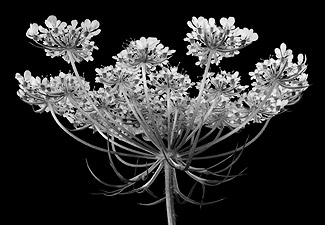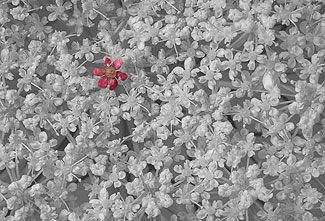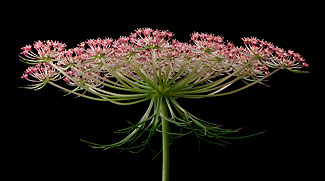|
||
|
Queen Anne's Lace, A Short Photographic Study . The blooms of Queen Anne's lace appearing all across the countryside mark mid-summer like brightly colored leaves mark autumn, but the bloom passes without much notice or fanfare. Having seen the Queen Anne's lace bloom come and go every year of my life, I decided to create a few images that explore the form of these common but fascinating plants. . |
||
| Queen Anne's lace (Daucus carota), is native to Europe and southwest Asia. It has grown wild in North America since colonial times when it was introduced as a medicinal plant that quickly spread across the entire continent. Because it is not native and can cause problems in agricultural operations, Queen Anne's lace is listed as a noxious weed by the US Department of Agriculture. Some gardeners love the plant and deliberately sow its seeds, while others loathe it and cannot purge it from their gardens. As they say, one person's weed is another person's flower. | ||
| . | ||
| The flower is named after either Queen Anne of England (1665-1714) or Queen Anne of Denmark (1574-1619). Both were avid lace makers. The single, small, red or purple floret that appears in the center of most blossoms is said to be a drop of Queen Anne's blood on the lace, which was produced as the result of a needle prick. The real function of the tiny red flower is to attract insects. Queen Anne's lace is also commonly known as wild carrot, bishop's lace, and birds nest weed, among many other names. | ||
| . | ||
| The vast majority of Queen Anne’s lace blossoms are white, very often with a single tiny red floret in the middle. Less frequently a cluster or the red florets forms in the center of the blossom. Rarely, the blossoms are entirely red. Of thousands of blossoms on many acres of land in several different locations, I found only two plants that were so colored. Each was surrounded by white-blossomed plants, and the two plants were in different areas. | ||
| . | ||
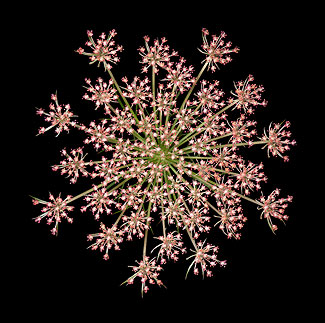 Queen Anne's Lace # 4 "Fireworks" |
Medicinal uses for Queen Anne’s lace were described by Hippocrates over 2000 years ago. An astounding number of medicinal uses for the plant have been found since then, and many of these have been confirmed by modern studies. The common vegetable carrot was derived from Queen Anne's lace. Like the carrot, Queen Anne's lace has a long edible root. Unlike the carrot, it quickly becomes too woody for consumption as the plant ages. | |
| . | ||
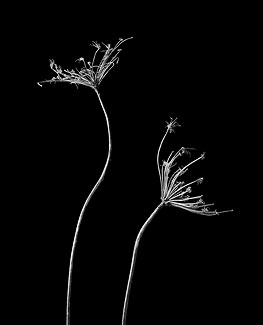 Queen Anne's Lace # 5 "Skeletons" |
Each Queen Anne's lace plant lives for two years. During its first year it forms a flat leafy rosette close to the ground, and produces no stems or flowers. During the second year a long branched stem topped with flowers appears. Then as autumn approaches Queen Anne's lace plants release their many small seeds and die. A few plants that grow in somewhat sheltered areas may remain as standing skeletons for more than a year, as did those shown to the left. | |
Content may not be reproduced or distributed without written permission. All Rights Reserved. |
||

